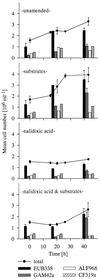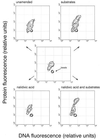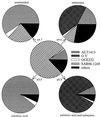Succession of pelagic marine bacteria during enrichment: a close look at cultivation-induced shifts
- PMID: 11055904
- PMCID: PMC92360
- DOI: 10.1128/AEM.66.11.4634-4640.2000
Succession of pelagic marine bacteria during enrichment: a close look at cultivation-induced shifts
Abstract
Enrichment experiments with North Sea bacterioplankton were performed to test if rapid incubation-induced changes in community structure explain the frequent isolation of members of a few particular bacterial lineages or if readily culturable bacteria are common in the plankton but in a state of dormancy. A metabolic inhibitor of cell division (nalidixic acid [NA]) was added to substrate-amended (S+) and unamended (S-) grazer-free seawater samples, and shifts in community composition and per cell DNA and protein content were compared with untreated controls. In addition, starvation survival experiments were performed on selected isolates. Incubations resulted in rapid community shifts towards typical culturable genera rather than in the activation of either dormant cells or the original DNA-rich bacterial fraction. Vibrio spp. and members of the Alteromonas/Colwellia cluster (A/C) were selectively enriched in S+ and S-, respectively, and this trend was even magnified by the addition of NA. These increases corresponded with the rise of cell populations with distinctively different but generally higher protein and DNA content in the various treatments. Uncultured dominant gamma-proteobacteria affiliating with the SAR86 cluster and members of the culturable genus Oceanospirillum were not enriched or activated, but there was no indication of substrate-induced cell death, either. Strains of Vibrio and A/C maintained high ribosome levels in pure cultures during extended periods of starvation, whereas Oceanospirillum spp. did not. The life strategy of rapidly enriched culturable gamma-proteobacteria could thus be described as a "feast and famine" existence involving different activation levels of substrate concentration.
Figures





Similar articles
-
Culturability and In situ abundance of pelagic bacteria from the North Sea.Appl Environ Microbiol. 2000 Jul;66(7):3044-51. doi: 10.1128/AEM.66.7.3044-3051.2000. Appl Environ Microbiol. 2000. PMID: 10877804 Free PMC article.
-
Are readily culturable bacteria in coastal North Sea waters suppressed by selective grazing mortality?Appl Environ Microbiol. 2003 May;69(5):2624-30. doi: 10.1128/AEM.69.5.2624-2630.2003. Appl Environ Microbiol. 2003. PMID: 12732530 Free PMC article.
-
Growth patterns of two marine isolates: adaptations to substrate patchiness?Appl Environ Microbiol. 2001 Sep;67(9):4077-83. doi: 10.1128/AEM.67.9.4077-4083.2001. Appl Environ Microbiol. 2001. PMID: 11526008 Free PMC article.
-
Differential growth response of colony-forming alpha- and gamma-proteobacteria in dilution culture and nutrient addition experiments from Lake Kinneret (Israel), the eastern Mediterranean Sea, and the Gulf of Eilat.Appl Environ Microbiol. 2003 Jan;69(1):199-211. doi: 10.1128/AEM.69.1.199-211.2003. Appl Environ Microbiol. 2003. PMID: 12513996 Free PMC article.
-
Diversity pattern of marine culturable heterotrophic bacteria in a region with coexisting upwelling and mud banks in the southeastern Arabian Sea.Environ Sci Pollut Res Int. 2022 Jan;29(3):3967-3982. doi: 10.1007/s11356-021-15772-8. Epub 2021 Aug 16. Environ Sci Pollut Res Int. 2022. PMID: 34398377 Review.
Cited by
-
Biodiversity of vibrios.Microbiol Mol Biol Rev. 2004 Sep;68(3):403-31, table of contents. doi: 10.1128/MMBR.68.3.403-431.2004. Microbiol Mol Biol Rev. 2004. PMID: 15353563 Free PMC article. Review.
-
Diatom-derived carbohydrates as factors affecting bacterial community composition in estuarine sediments.Appl Environ Microbiol. 2007 Oct;73(19):6112-24. doi: 10.1128/AEM.00551-07. Epub 2007 Aug 3. Appl Environ Microbiol. 2007. PMID: 17675437 Free PMC article.
-
Marine cyanolichens from different littoral zones are associated with distinct bacterial communities.PeerJ. 2018 Jul 17;6:e5208. doi: 10.7717/peerj.5208. eCollection 2018. PeerJ. 2018. PMID: 30038864 Free PMC article.
-
Viral Regulation on Bacterial Community Impacted by Lysis-Lysogeny Switch: A Microcosm Experiment in Eutrophic Coastal Waters.Front Microbiol. 2019 Jul 31;10:1763. doi: 10.3389/fmicb.2019.01763. eCollection 2019. Front Microbiol. 2019. PMID: 31417537 Free PMC article.
-
Identification of DNA-synthesizing bacterial cells in coastal North Sea plankton.Appl Environ Microbiol. 2002 Nov;68(11):5728-36. doi: 10.1128/AEM.68.11.5728-5736.2002. Appl Environ Microbiol. 2002. PMID: 12406771 Free PMC article.
References
-
- Albertini S, Chetelat A A, Miller B, Muster W, Pujadas E, Strobel R, Gocke E. Genotoxicity of 17 gyrase and four mammalian topoisomerase II poisons in prokaryotic and eukaryotic test systems. Mutagenesis. 1995;10:343–351. - PubMed
-
- Ammerman J W, Fuhrman J A, Hagstöm A, Azam F. Bacterioplankton growth in seawater. I. Growth kinetics and cellular characteristics in seawater cultures. Mar Ecol Prog Ser. 1984;18:31–39.
Publication types
MeSH terms
Substances
LinkOut - more resources
Full Text Sources
Miscellaneous

